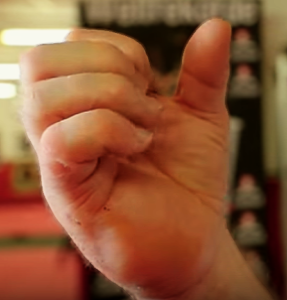The one-inch punch, often referred to simply as the inch punch, is a striking technique that epitomizes the idea of efficiency in martial arts. It’s a powerful, short-range punch that can deliver significant force with minimal movement. The beauty of the inch punch lies in its simplicity; it requires only a small distance to generate explosive power.
This technique is not just about brute strength; it’s a combination of body mechanics, timing, and precision. When executed correctly, the punch can incapacitate an opponent with a single, well-placed strike, making it an invaluable tool in close-quarter combat scenarios. What sets the inch punch apart from traditional punches is its focus on generating power from a stationary position.
Instead of relying on a long wind-up or extensive movement, the practitioner uses their entire body to create force in a compact motion. This makes it particularly effective in situations where space is limited, such as in grappling or confined environments. The punch is not merely about the fist; it’s about the alignment of the body, the transfer of weight, and the kinetic chain that connects the feet to the fist.
In essence, the inch punch is a testament to the principle that sometimes less is more, especially when it comes to delivering devastating strikes.
Key Takeaways
- The Inch Punch is a martial arts technique that delivers a powerful blow from an extremely short distance.
- The One Inch Punch has a long history, with roots in Chinese martial arts and popularized by Bruce Lee.
- To perform the 1in Punch, the practitioner must generate power from a short distance using precise body mechanics.
- The science behind the Inch Punch involves the transfer of kinetic energy and the use of body alignment and muscle coordination.
- Training for the Inch Punch involves developing strength, speed, and precision through specific exercises and drills.
The History of the One Inch Punch
The Legendary Bruce Lee and the Popularization of the One-Inch Punch
The technique gained widespread recognition through the legendary martial artist Bruce Lee, who popularized it in the 20th century. Lee’s demonstrations showcased not only the effectiveness of the one-inch punch but also his philosophy of martial arts as a means of self-expression and personal development. His ability to deliver such force from a mere inch away captivated audiences and inspired countless practitioners around the world.
The Evolution and Adaptation of the One-Inch Punch
As Bruce Lee’s influence spread, so did interest in the one-inch punch itself. It became emblematic of his approach to martial arts—one that valued practicality over tradition and emphasized adaptability in combat situations. The technique has since been adopted by various martial arts disciplines, each adding its own flavor and interpretation. From karate to mixed martial arts (MMA), the principles behind the one-inch punch have been integrated into training regimens, proving that its effectiveness transcends cultural boundaries.
A Symbol of Martial Arts Innovation
Today, the one-inch punch stands as a symbol of martial arts innovation and a reminder that true power often lies in precision and technique rather than sheer force.
How to Perform the 1in Punch

Executing the one-inch punch requires a blend of technique, body mechanics, and mental focus. To begin, stand in a natural stance with your feet shoulder-width apart. Your dominant foot should be slightly behind you for stability.
The key to the inch punch is to maintain a relaxed posture while ensuring your body is aligned correctly. As you prepare to strike, draw your fist back slightly while keeping your elbow close to your body. This positioning allows for maximum power generation without unnecessary movement.
When you’re ready to deliver the punch, focus on transferring your weight from your back foot to your front foot in a fluid motion. As you shift your weight forward, simultaneously rotate your hips and shoulders toward your target. This rotation is crucial; it’s what generates the explosive power characteristic of the inch punch.
Finally, extend your arm in a straight line toward your target while keeping your fist relaxed until the moment of impact. The goal is to strike with precision at the very end of your punch, allowing your body’s momentum to transfer through your fist and into your opponent. Practice this motion repeatedly, focusing on timing and coordination until it becomes second nature.
The Science Behind the Inch Punch
The effectiveness of the one-inch punch can be attributed to several scientific principles related to biomechanics and physics. At its core, the inch punch relies on the concept of kinetic energy transfer. When you execute this punch, you’re not just using your arm; you’re engaging your entire body to create a chain reaction that culminates in a powerful strike.
The energy generated by your legs and core muscles travels through your torso and into your arm, resulting in a concentrated burst of force at impact. Moreover, the mechanics of leverage play a significant role in enhancing the power of the inch punch. By keeping your elbow close to your body and utilizing rotational movements, you’re effectively maximizing the force applied at a short distance.
This principle is similar to how a whip works; it’s not about how far you swing but how efficiently you transfer energy through each segment of movement. Additionally, psychological factors such as surprise and timing can amplify the effectiveness of this technique. An opponent may not expect such a powerful strike from such a short distance, making it all the more effective when executed correctly.
Training for the Inch Punch
Training for the one-inch punch involves more than just practicing the motion itself; it requires developing strength, speed, and coordination throughout your entire body. One effective way to build these attributes is through targeted strength training exercises that focus on core stability and explosive power. Movements like squats, deadlifts, and medicine ball throws can help enhance your overall strength while also improving your ability to generate force quickly.
In addition to strength training, practicing specific drills can help refine your inch punch technique. Shadowboxing with an emphasis on short-range strikes allows you to focus on form without worrying about an opponent. Partner drills can also be beneficial; working with a training partner who can provide resistance or feedback will help you gauge your power and accuracy.
Finally, incorporating plyometric exercises into your routine can improve your explosive speed—think box jumps or clap push-ups—to ensure that when you throw that one-inch punch, it’s not just powerful but also lightning-fast.
Applications of the One Inch Punch

Practical Applications of the One-Inch Punch
The one-inch punch is more than just a demonstration technique; it has practical applications in both self-defense and combat sports. In close-quarter combat situations where space is limited, the ability to deliver a powerful strike from a short distance can be a significant advantage. Whether you’re in a grappling exchange or facing an opponent who has closed the distance, being able to generate significant force with minimal movement can create openings for escape or counterattacks.
Breaking Free from Holds and Creating Space
In grappling scenarios, the one-inch punch can be an effective tool for breaking free from holds or creating space between you and an opponent. For example, if an adversary has you in a clinch or is attempting to take you down, delivering an inch punch can disrupt their balance and give you an opportunity to escape or reposition yourself.
Enhancing Self-Defense Skills and Competitive Performance
The versatility of the one-inch punch makes it an essential technique for anyone looking to enhance their self-defense skills or improve their performance in competitive settings. By mastering this technique, individuals can gain a valuable advantage in close-quarter combat situations and improve their overall effectiveness in both self-defense and competitive scenarios.
Famous Practitioners of the 1in Punch
While many martial artists have embraced the one-inch punch over the years, few have done so with as much flair and effectiveness as Bruce Lee himself. His demonstrations not only showcased his incredible skill but also inspired generations of martial artists to explore this powerful technique further. Lee’s ability to deliver devastating strikes from such short distances became legendary; he was able to break boards and even knock opponents back with seemingly little effort—a testament to his mastery of body mechanics and energy transfer.
In addition to Bruce Lee, other notable practitioners have also made their mark with this technique. Martial artists like Ip Man—Lee’s Wing Chun teacher—demonstrated its effectiveness within traditional Chinese martial arts contexts. More recently, fighters in mixed martial arts (MMA) have incorporated elements of the inch punch into their striking arsenal, recognizing its utility in both stand-up exchanges and grappling scenarios.
As martial arts continue to evolve, so too does the legacy of the one-inch punch—a technique that remains relevant and effective across various disciplines and combat situations.
For those interested in enhancing their martial arts skills, particularly in mastering the one-inch punch, a technique made famous by Bruce Lee, you might find the article “One Inch Punch for Close Combat” highly relevant. It delves into the practical applications of the one-inch punch in close combat scenarios, offering insights and training tips to effectively utilize this powerful strike. You can read more about it and improve your martial arts technique by visiting one inch punch for Close Combat.